Newsletter

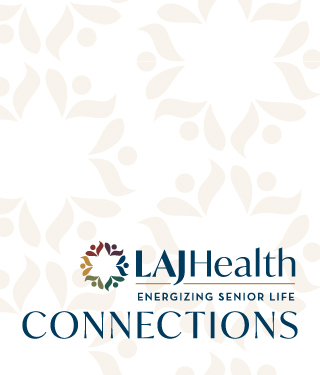
Our Newsletter
Connections
Apr
1
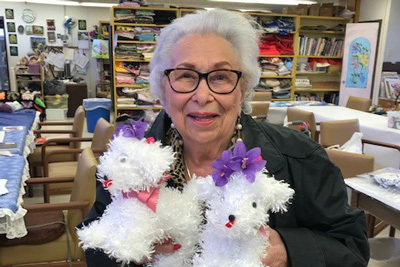
“This Shall Pass:” Jewish Home Seniors Share Their Wellness Wisdom
Many of us feel challenged by the current stay-at-home orders, including our socially isolated residents. To protect their health, our staff are delivering meals to our residents' rooms, finding creative ways to keep them active and doing their best to accommodate their emotional and physical needs as they shelter in place.Overall, however, our residents are resilient people. Some are Holocaust survivors, while others have struggled and overcome other personal hardships. Ask a resident how they're doing while under social isolation, and they'll tell you that while it's difficult, they understand it's necessary for their own good, as well as the greater good. They are making the best of the situation.
"This shall pass," advises Edith Frankie, a survivor of the Nazi concentration camps. "People don't like restrictions. Me? I'm used to it. Staying in our rooms is not so hard in comparison."Frankie lives on the Home's Grancell Village campus at the Joyce Eisenberg-Keefer Medical Center. She keeps her hands busy by crocheting. She keeps her mind busy by playing word games organized by the activities staff."People who feel isolated should do some exercises," she says. "I have been working out three times a week in our fitness center. The staff know what they're doing. I feel so much better after doing exercises for a half an hour.""They are doing a fantastic job here trying to keep us upbeat," says Leslie Scales, who lives at Eisenberg Village. "We miss our families. But there's not much else we can do. We are safe and healthy and that's all that matters."Scales looks forward to playing the daily "Dial-A-Bingo" games and receiving her lunch in her room. "The dietary staff are phenomenal," she says.
Meanwhile, Michal Robins, who also lives at Eisenberg Village, limits her TV-watching to once a day. The behavior therapist spends her time listening to music and writing a book for fellow therapists.And, as president of the resident council, Robins finds herself in a leadership role during the pandemic. "I'm teaching others to be positive. People are antsy being by themselves," she says. "But the staff here are doing a great job reminding us to practice good hygiene and to keep a safe distance."A Juilliard-trained musician, Robins is hopeful that she'll be able to return soon to leading the Oneg Shabbat concert and sing-a-long. "If we trust the experts, follow their instructions, and take our vitamins, we'll see better times. We hope for a miracle and push the days until we have a vaccine," she says.Resident Marilyne Holm, a former fashion designer, spent most of her time in the Eisenberg Village art room before the mandatory lockdown. While she misses the camaraderie of working in the art room, she is managing to stay productive, thanks to a Los Angeles Jewish Health staff member who delivers art supplies to her room.Holm is known for creating Mendels (little stuffed dogs wearing yarmulkes), which she sells to the public. She's been continuing to sew them, as well as teddy bears, in her room. "I'll have a whole kennel once lockdown is done," she says.Like her fellow residents, Holm understands that socially isolating is necessary. "I know this has to be done," she says. "Thank God I'm here at the Home, where I'm safe."
Mar
31
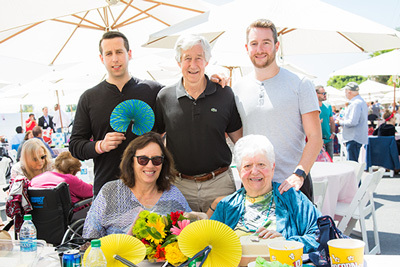
A Special Mother’s Day Celebration
The Los Angeles Jewish Home treasures all the beloved mothers, grandmothers and great-grandmothers in our care. Their safety and well-being is our top priority. As always, the Home wants these women to have a special and meaningful Mother's Day celebration.
This year, in response to the COVID-19 pandemic, the traditional World's Largest Mother's Day Celebration will be for residents only. As part of the celebration, the women at the Home will receive a gift, special meal and a nice day to show our love and appreciation!
If you wish to pay tribute and honor your mothers, grandmothers and great-grandmothers, the Home will create and produce a digital tribute journal that will include tributes and special messages. The digital tribute journal will be distributed via email to over 15,000 people so the entire community can celebrate our mothers, grandmothers and great-grandmothers. We will also have copies available on a USB device so all of our residents can view it.
If you wish to place a special message in our tribute journal, please send an e-mail to [email protected] or call Denise Horowitz at 818-774-3324.
Mar
31
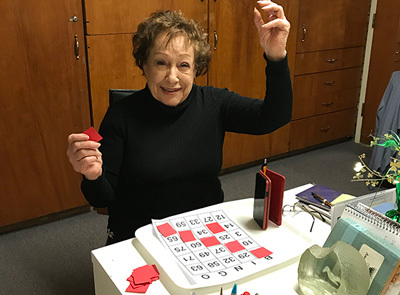
Serving the Needs of Our Residents, from Shabbat to Bingo
At the Los Angeles Jewish Home, our residents are accustomed to enjoying a wide range of engaging activities on a daily basis. Shabbat services, sing-a-longs and games of Bingo, are all integral parts of the Jewish Home experience.
Now with social distancing in place to slow the spread of COVID-19 (Coronavirus), our staff are coming up with creative ways to engage with our residents to help combat the feelings of isolation.
To "pierce that isolation" and serve the spiritual needs of our residents, Rabbi Karen Bender, the Home's Skirball Director of Spiritual Life, teamed up with Eisenberg Village's Rabbi Ron Goldberg to bring Shabbat services directly to the residents (while keeping a safe six-foot distance apart).
Rabbi Bender led what she calls a "Shabbat serenade" through the hallways at both Joyce Eisenberg-Keefer Medical Center (JEKMC) and the Mark Taper Skilled Nursing Building on Grancell Village. With guitar in hand, Bender appeared on every floor and at the entrance of every room, singing Shabbat songs and wishing residents "Shabbat Shalom!"
"People laughed and smiled and clapped along to the music," Bender said. It took her nearly two hours, but she wanted each resident to know that despite the mandate to remain isolated, none of them is forgotten.
Rabbi Goldberg toured the hallways at Eisenberg Village, accompanied by Volunteer Services Director Stacy Orbach and Lifestyle and Enrichment Director Annette Weinberg, singing songs. "Residents opened their doors as they heard the music," Orbach said. "We sang together, we danced together and we cried together (of course exercising social distancing). I witnessed joy, happiness and gratitude from our residents like never before."
And at Fountainview at Eisenberg Village, Activities Coordinator Lauri Kamiel and Lifestyle and Enrichment Director Carolyn Clark took their "Welcoming Shabbat" show "on the road" to their residents. "From their doorways, we sang Shabbat songs, and said the blessings for the candles, wine and Challah," Kamiel said.
Earlier in the week, Kamiel and Clark toured the hallways with a cart full of board games. They knocked on residents doors and shared some jokes and songs. The duo agreed that one of the highlights came when everyone sang "Tomorrow," from the musical "Annie." "Many residents are familiar with this song and joined us in an uplifting, feel-good moment," Kamiel said.
Staying in Touch
While the Home's Brandman Centers for Senior Care (BCSC), recently closed its day center, in compliance with guidance from California and the City of Los Angeles, the BCSC Clinic and Therapy services will continue to remain open to meet essential healthcare needs.
In the meantime, even though most of the participants, who reside in the local community, are not physically in the BCSC Day Center, BCSC staff are doing everything they can to keep them healthy and well. Staff are calling to check in with participants, sending health care providers out into the community, delivering both meals and supplies to those who need them, and sending care packages to keep participants engaged.
Dial-A-Bingo
If you've spent time at the Eisenberg Village campus, then you know how passionate residents are about their Bingo games. To help fill that void, Weinberg, came up with a solution: Dial-A-Bingo.
Weinberg distributed a flyer detailing the rules with a phone number for interested residents to use if they wanted to play. Then she handed out Bingo cards and colored paper squares to cover the called numbers. Weinberg, along with Orbach and Sandy Schipper, Lifestyle and Enrichment Assistant, phoned the residents and connected them into a conference call. They called the out the numbers, told jokes and kept track of the winners.
"All the residents who have played say it's a lot of fun," according to Weinberg. "They appreciate the effort. Residents are having so much fun that the word is getting out and more and more want to play. We plan to offer this daily during the week."
For resident Audrey Barger, who in normal times, volunteers as one of the Bingo callers on the EV campus, the activity is a welcome break from the daily routine. "Everybody looks forward to Dial-A-Bingo," she says. "It's a great way for us to connect with each other."
Putting Out the Word
To brighten the hours of our residents' days, we've put out the word that they would love to receive cards, pictures or letters! And, families have already responded to the call. If you would like to join the effort, please direct your cards and letters to our Director of Volunteer Services, Stacy Orbach, at our Eisenberg Village Campus at 18855 Victory Blvd, Reseda, CA 91335.
Mar
31
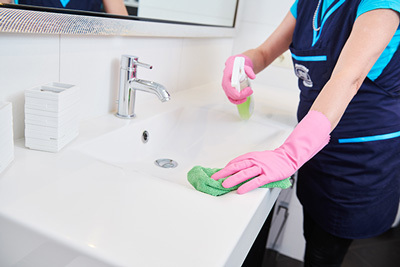
Develop a Household Plan to Face COVID-19
Here at the Jewish Home, the safety and health of our community remains one of our greatest priorities.
Below is guidance we received from the Centers for Disease Control and Prevention (CDC) on what you can do to safeguard your home against Novel Coronavirus, otherwise known as COVID-19.
Stay informed about the local COVID-19 situation. Get up-to-date information about local COVID-19 activity.Stay home if you are sick. Stay home if you have COVID-19 symptoms. If a member of your household is sick, stay home from work and school to avoid spreading COVID-19 to others. If your children are in the care of others, urge caregivers to watch for COVID-19 symptoms.Continue practicing everyday preventive actions. Cover coughs and sneezes with a tissue and wash your hands often with soap and water for at least 20 seconds. If soap and water are not available, use a hand sanitizer that contains 60% alcohol. Clean frequently touched surfaces and objects daily using a regular household detergent and water.Prepare a separate room and bathroom for sick household members (if possible). Avoid sharing personal items like food and drinks. Provide your sick household member with clean disposable facemasks to wear at home, if available, to help prevent spreading COVID-19 to others. Clean the sick room and bathroom, as needed, to avoid unnecessary contact with the sick person.If surfaces are dirty, they should be cleaned using a detergent and water prior to disinfection. For disinfection, a list of products with EPA-approved emerging viral pathogens claims, maintained by the Center for Biocide Chemistries, is available here and here. Always follow the manufacturer's instructions for all cleaning and disinfection products.Always read warning and ingredient labels on cleaning and disinfecting products and remember … NEVER MIX CLEANING PRODUCTS!Stay in touch with others by phone or email. If you live alone and become sick during a COVID-19 outbreak, you may need help. If you have a chronic medical condition and live alone, ask family, friends, and health care providers to check on you during an outbreak. Stay in touch with family and friends with chronic medical conditions.Take care of the emotional health of your household members. Outbreaks can be stressful for adults and children. Children respond differently to stressful situations than adults. Talk with your children about the outbreak, try to stay calm, and reassure them that they are safe.
Mar
17
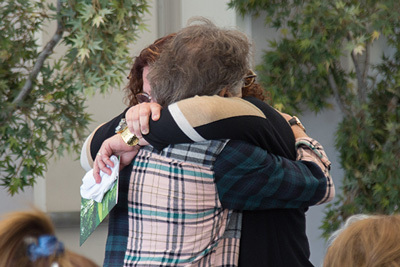
Skirball Hospice Service a Bridge from Memory to Blessing
In the days and months after their patients pass away, the Jewish Home's Skirball Hospice remains in the lives of their patients' families and loved ones. They offer bereavement support in the form of one-on-one counseling, personal letters and phone calls.
Since 2014, Skirball Hospice has hosted a memorial service to honor the memory of the patients in their care who have passed away throughout the year.
"Families and loved ones can often feel alone because they think no one else is feeling what they're feeling," says Ashley Teal, executive director of Skirball Hospice. "The memorial service provides people with an opportunity to sit and grieve together—to be with people who understand that their worlds have changed and reflect on that."
This year's service was held in March at the Skirball Cultural Center.
Bereavement Coordinator Alice Lynn, who organized the service, introduced the program: "Today, we gather as a community comprised of families, friends and Hospice team members. Today we celebrate those who have passed. We remember the love, laughter and priceless memories you may have shared."
During the program, Skirball staff and volunteers lit candles, performed music and shared readings. A moving ritual of building a matzevah, or altar of stones, to represent the individuals being remembered was also part of the program. As each patient's name was read, a stone was placed in their memory. Family members and loved ones were then encouraged to share their stories and memories.
For Mitzi Schwarz, the memorial service was especially poignant.
Schwarz is one of Skirball Hospice's spiritual counselors. She works with patients and their families "bearing witness," she says, to what they are going through during the end-of-life stage. In this capacity, Schwarz had attended and performed at three Skirball memorial services. However this year, she was grieving her own father, who had been a Skirball patient.
"It was a blessing for me," Schwarz says of her father's time as a Skirball patient. "To be supported by the Skirball Hospice team felt like I was being supported by my family. No one was a stranger."
At the memorial, Schwarz says she felt comforted by being in the presence of her fellow mourners. "I was able to just let my emotions flow," she recalls. "Being with other families whom I had helped throughout the year deepened the experience."
For more information on the Skirball Hospice program, please call 818-774-3040 or visit skirballhospice.org.
Mar
17
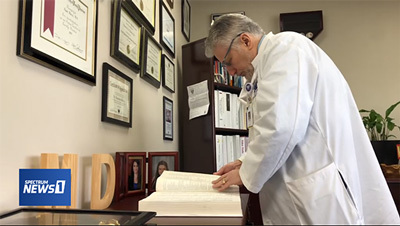
Dr. Marco Interviewed on the Jewish Home’s Increasing Safety Efforts Amid Coronavirus Concerns
"We have never seen anything like this, and I'm worried, I am very concerned and worried about our residents and their families," states Dr. Noah Marco in a recent interview with Spectrum News.
As the concerns about the Coronavirus and its subsequent illness named COVID-19 continue to surface, news agencies have been reaching out to Dr. Marco and the Los Angeles Jewish Home to learn more about the important procedures the Home has taken to protect its patients and residents.
Catalina Villegas of Spectrum News visited the Home and filmed this interview with Dr. Marco, highlighting the steps the Home has implemented. Here are just a few featured in the piece:
Daily meetings with the leadership team, laying out plans and discussing everything from procedures with vendors to testing.Cancelling resident interaction with the communityIncreasing safety guidelines and protocols.Boosting communication with families, and visitors through voicemails, their website and fliersVisitors, staff, and vendors are being asked to go through a screening process before entering the facility, detailing their recent medical history, including travel and symptomsThey're also taking temperatures and ensuring everyone is screened
To watch the interview or read a transcript, visit the Spectrum News site at https://spectrumnews1.com/ca/la-west/health/2020/03/12/socal-nursing-homes-increasing-safety-efforts-amid-coronavirus-concerns#. Spectrum is providing free access to its content on the Coronavirus for thirty days.
Mar
12
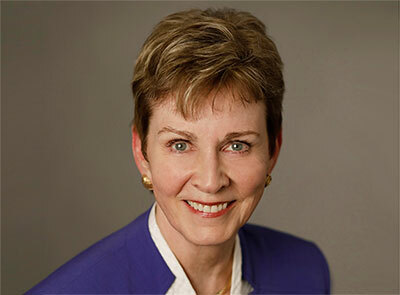
The Jewish Home’s Response to Coronavirus (COVID-19)
Dear Family and Friends,
Following the recent developments of COVID‐19 in the U.S., particularly in senior living communities, we are reaching out to inform you of how we are handling this situation at the Los Angeles Jewish Home. As of today, there are no known or suspected cases of COVID‐19 among residents, patients, staff, volunteers or visitors in any of our programs. However, we are taking extra precautions to keep each of our communities as safe as possible during such a critical time.
Our policy for visitation is in compliance with guidance from the Department of Public Health, the Centers for Disease Control, and the Center for Medicare and Medicaid Services. Their advice to limit the transmission of COVID‐19 includes the following measures which have been put into place effective immediately:
At the following locations: Grancell Campus Village; Eisenberg Campus Village; Fountainview at Eisenberg Village; and Fountainview at Gonda Healthy Aging Westside Campus, we are limiting all visitors to our communities until further notice. We ask that all family and friends refrain from visiting until further notice. The only exception is if a resident is “actively dying” when known by us. An exception may be made if there is any change or significant decline in your loved ones condition. If you require special access for these reasons or others, please contact us.All Jewish Home staff, vendors, and visitors (determined to be essential) are being actively screened daily as they enter the campus. We follow strict procedures to limit possible exposure of this virus to those we serve.
We understand it is incredibly important to stay in contact with your loved ones and staff and we are making every effort to minimize the impact of these guidelines. We encourage you to use standard communication methods to maintain contact with your loved ones for the time being. You may choose to contact them via telephone, email, text messaging or Skype. As always, the well-being of our residents, staff and visitors is our top priority and we appreciate your understanding and cooperation during this time.
Evaluations from prior viral epidemics that spread like COVID‐19 found that actions taken early in outbreaks can significantly reduce the spread of the virus ‐ waiting until the virus is spreading in the community is often too late. These measures will stay in place until we are advised or feel comfortable to lift them. We are grateful for your understanding and cooperation during this challenging time.
As things evolve regarding the COVID‐19 situation, we will communicate proactively and transparently as soon as warranted.
Thank you,
Molly ForrestCEO and President
Noah Marco, M.D.Chief Medical Officer
Mar
6
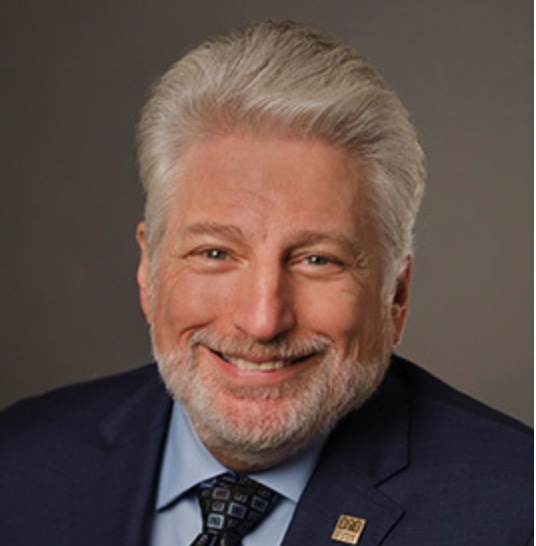
An important message on the Coronavirus from Dr. Marco
COVID-19, a strain of the Coronavirus, has recently been in the news. The Los Angeles Jewish Home (LAJH) and all of its programs have no identified threat at this time. Currently, there are only a handful of cases in our city, but that is likely to change. Our leadership team is staying abreast of the situation and monitoring communications from the government programs that advise health care institutions.
On March 4, 2020, the Centers for Medicare and Medicaid Services (CMS) announced “Actions to Address Spread of Coronavirus.” CMS announced several actions aimed at limiting the spread of the Novel Coronavirus 2019 (COVID-19). Specifically, CMS issued a call to action to health care providers across the country to ensure they are implementing their infection control procedures. The LAJH has answered that call. We are maintaining and supplementing our infection control procedures.
Our priority remains the protection from harm of the most vulnerable members of our community.
In that regard, we are implementing several actions:
We suspended sending our residents out into the community for social activities.We are cancelling group activities of our residents where they interact with people from the outside community.We are asking visitors to minimize coming to see our residents and educating them not to come if they are not well.We have assessed our inventory of protective equipment (gowns, gloves, masks) and determined we currently have an adequate supply (but we ordered more).We will screen all new admissions if they have any of the known risk factors to transmit this virus.We have been educating and training our staff on how to follow the published guidelines on how to minimize spreading of this illness.Additional cleaning of our environment will occur using products that we have been told kill this virus.We will minimize our staff gathering in one room for routine discussions and use other forms of communication when appropriate.We will continue to stay in direct communication with state and local public health agencies.We will begin a process to screen visitors if they have any of the known risk factors to transmit this virus (as instructed by CMS).
The CDC has made recommendations on how to prevent the spread of the virus. Like the flu, thorough handwashing is the best technique to prevent the virus. Below are other recommendations:
Stay Home. Do not leave your residence if you feel ill. Call your doctor to report your illness. Refrain from going into public places.Separate yourself from other people in your home. If you live with others, it’s best to separate yourself to another room, and if possible to use a separate bathroom.Cover coughs and sneezes. Cover your mouth and nose with a tissue, and dispose of it into a trash can. If a tissue is not available, cough or sneeze into your elbow. Wash your hands after.Avoid sharing household items. Avoid sharing drinking glasses, dishware, and towels. These items should be washed thoroughly with soap and warm water after use.Keep your hands clean. Wash your hands often and thoroughly with soap and water, for at least 20 seconds, with friction. Use alcohol based hand sanitizer. Avoid touching your face with unwashed hands. Good hand washing is the best way to prevent the spread.
Please help keep our residents safe. Please do not come onto our campus for routine visits. If you feel ill or have come in contact with someone who is suspected of having COVID-19, DO NOT VISIT.
It is unlikely that we will be able to provide a visitor screening process 24 hours per day. Therefore, visiting hours will be restricted to the times when we have clinicians available. You will not be allowed to enter our facilities if it is determined you pose a risk to those we serve.
It is our commitment to you to inform you of any changes of our plans or instructions we get from public health agencies.
Thank you for your partnership.
Noah Marco, M.D.Chief Medical OfficerLos Angeles Jewish Home
Feb
29
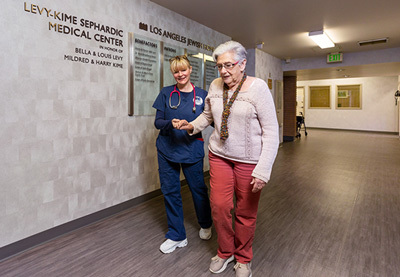
Renovated Clinic Offers Comfort and Community
The Jewish Home's Levy-Kime Geriatric Community Clinic recently received a makeover, including upgraded equipment and amenities.
Located on the Eisenberg Village campus, the clinic provides residents with primary and specialty medical care.
"The medical care we provide is convenient, easily accessible and essential to the well-being of our residents," says Stephen Martinez, Ph.D., executive director of the Levy-Kime Geriatric Community Clinic and the Los Angeles Jewish Home's Independent Practice Association (IPA).
Martinez oversaw the renovation of the clinic, which is open weekdays.
"These renovations are the result of our striving for the highest level of wellness for our residents," he says. "We upgraded to maximize our space and modernized the look of the entire clinic. We went through each room and identified what was needed, whether it was new equipment, lighting or a coat of paint."
In addition, new works of art now adorn the walls of the Clinic, thanks to the efforts of Nancy Katz and Nancy Meshulam, co-chairs of the Jewish Home's Art Committee.
For Dr. Noah Marco, the Home's chief medical officer, the upgrades are a source of pride. "I am so honored to join my clinician colleagues to work in such a healing environment," he says.
Dr. Marco notes that he is particularly proud of the new space for counseling and psychotherapy. Formerly a doctor's office, the room, he says "feels like a living room. It is a relaxing and healing space and has a different feel than most outpatient clinics."
Martinez adds that he's witnessed how the aesthetic improvements have had a psycho-social benefit for the residents.
"Just improving the appearance of the clinic improves the overall satisfaction of our residents and increases their feelings of comfort and community," Martinez says.
Resident Leslie Scales, who recently visited the clinic for a podiatrist appointment, definitely approves of the clinic's refreshed look. "It's lovely," she says. "I especially love the new artwork!"
Above all, however, Scales praises the care she receives at the clinic. "The nurses couldn't be any better. They are so accommodating," she says. "I'm pleased with all of my doctors here and with the care I get."
And that's the payoff Martinez seeks. "It's so satisfying to see the residents go into the clinic and emerge feeling grateful," he says.